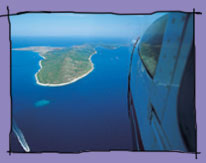Unije - a unique island.
The island with the homonymous settlement (44º 38' N and 14º 15' E) is situated in Kvarner bay, to the northwest of Lošinj. With a surface of 16.77 sq. km it has 90 inhabitants 81991). Unije is one of the islands situated furthest to the west in the series of small open-sea Adriatic islands of Zeča, Srakane and Susak. The island is hilly (its highest peak is Kalk, 138 m) and former of limestone. The northwestern open-sea coast is steep (Vele and Male Stijene), whereas the southwestern part, with its small peninsula of Polje, has fertile land, loess and drinkable water spring. Polje has recently started to serve as a sports airport as well. The other parts of the island are mostly covered with macchia, but there are also abandoned fields as well as those under cultivation, mostly olive-groves.
Today, the island of Unije offers genuine, truly preserved nature and, due to its open position, extremely clean seawater. Apart from the local inhabitants, numerous enthusiasts of the island's exceptional beauty have moved to the island lately.
There is no automobile traffic on the island.
NAME
The name Unije stems from the Greek word heneios (neios, nia), meaning field. A Croatian equivalent of the name would therefore be Upolje – meaning "In the field"!
FIRST MENTION
The first information about Unije is delivered by the Venetian Jesuit Alberto Fortis in his famous work Journey through Dalmatia from 1774: Unije (Onie) has few inhabitants and they are all very poor. Their main product is wood, because the island is mostly covered by forest. They could produce great quantities of honey and wax and breed cattle, but they do not. The sea around Unije is rich with fish, mostly tuna, mackerel and pilchard, but the poor inhabitants do not profit from that at all, so that strangers come and catch all the fish under their noses.
ZAJAVORI, MARAČOL, KAMBUNARA...
Such strange names! But, as soon as one explores the source of these place names, it all becomes clear! Zjavori is a laurel grove (javor means laurel), Maračol, a shallow bay, got its name from the Italian word marazzo (swamp) and Kambunara, like Kambuni on the island of Krk, derives from the Provencal word cambon (field).
MEDICINAL AND AROMATIC HERBS
The naturally preserved vegetation of Unije is rich with various aromatic and medicinal herbs, especially fennel, feverwort, sage, myrtle and heather.
POPULATION
In 1921 Unije reached its highest population count (783), but after that date many islanders emigrated, mostly to the United States. Like the inhabitants of the neighboring island of Susak, most of them went to New York and Hoboken. Many also moved inside Croatia or settled on the nearby island of Mali Lošinj. Today the inhabitants of Unije, many of whom have returned from America, live mostly on agriculture and tourism.
GETTING THERE
Unije can be reached by boat "Ozalj" from Mali Lošinj, 14 NM away from Unije, and by "Judita" from Rijeka. Unije can also be reached by sports plane from Lošinj, Vrsar and Medulin.
MEAN MONTHLY AIR TEMPERATURE
| January | 7,5ºC | May | 17,7ºC | September | 21,3ºC |
| February | 7,6ºC | June | 21,8ºC | October | 16,1ºC |
| March | 9,8ºC | July | 24,6ºC | November | 12,1ºC |
| April | 13,7ºC | August | 24,3ºC | Decembre | 9,3ºC |
Photos: Dubravko Harapin, Asia Krstulović, Snježana and Goran Nemarnik, Mio Vesović, Tea and Edo Vidovič
